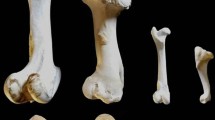Abstract
Monitoring of the morbidity caused by limb disorders has been conducted. The morphofunctional status and the strength of the bone system in the cattle of domestic selection compared to the imported animals in the modern cattle industrial system were determined. The morphological properties of the experimental animal locomotor apparatus were analyzed with the methods of V.Ya. Brovar. Limb bone physical properties were examined for tension-compression with a UIM 10 universal test device. The ultimate compressive bone strength was estimated with the ratio of the maximum applied load that the bone sample could sustain to the area of that sample. The surveys proved that the higher limb disease rates both in the absolute (per 58–72 head) and relative units (19.3–24.4%) were recorded in the American Holstein cows compared to the domestic cattle populations. It was ascertained that it required significantly more effort to destroy a bone sampled from the animals of a domestic population than the material obtained from the imported livestock. With respect to the metacarpal and metatarsal bones, the differences comprised 888–1315 kg (P > 0.95–0.99) and 937–1335 kg (P > 0.95), respectively. The bone-breaking strength in the Brown Swiss, Red Steppe, and American Holstein animals comprised 374.6 kg/cm2, 359.3 kg/cm2, and 291.7 kg/cm2, respectively. This indicates the greater bone-strength properties in the animals of the domestic populations, which can provide the opportunity to keep them both in the distant high-pasture system and the stall housing system. The morphometric analysis and the bone-breaking strength tests can prove the higher resistance to limb disorders in the domestic Brown Swiss and Red Steppe livestock bred for a long time under the strong pressure of natural selection when compared to the American Holsteins imported into the North Caucasus area and kept under the effect of hypokinesia.
Similar content being viewed by others
REFERENCES
Aleksina, L.A., On the dynamics of synostosis of human long tubular bones, Arkh. Anat. Gistol. Embriol., 1985, no. 11, pp. 69–74.
Brovar, V.Ya., Sily tyazhesti i morfologiya zhivotnykh (Gravity and Morphology of Animals), Moscow: Sel’khozgiz, 1960.
Itskovich, G.M., Soprotivlenie materialov (Strength of Materials), Moscow: Vysshaya shkola, 1998.
Krishtoforova, B.V., Morphofunctional adaptation of the skeletal system of young productive animals, S-kh. Biol., 1990, no. 4, pp. 95–101.
Nazarchenko, O.V., Efficiency of long-term use of black-and-white cows of the Ural type of Zauralye, Vestn. Michurinsk. Gos. Agrarn. Univ., 2011, nos. 1–2, pp. 34–36.
Pankratov, A.A. and Zasukhina, O.A., Omegometriya skota (Cattle Omegometry), Krasnodar: Kuban. Gos. Agrarn. Univ., 2005.
Pimenov, M.Yu., Determination of toughness of metacarpal and metatarsal bones in cattle of Kostroma breed in comparative aspect, Mir Sovrem. Nauki, 2011, no. 2, pp. 5–9.
Plokhinskii, N.A., Rukovodstvo po biometrii dlya zootekhnikov (Biometrics Guide for Livestock Zootechnicians), Moscow: Kolos, 1969.
Sakhno, N.V., Method for determining the strength of animal bones using test machines, S-kh. Biol., 2008, no. 6, pp. 122–125.
Skopinskii, V.N. and Zakharov, A.A., Soprotivlenie materialov: Uchebnoe posobie (Resistance of Materials: Tutorial), Moscow: Mosk. Gos. Ind. Univ., 1999.
Stetsenko, I.I., Lyubin, N.A., and Shlenkina, T.M., Growth activity and strength of bones of pigs' skeleton with the introduction of mineral supplements into the ration, Vestn. Ul’yanovsk. Gos. S-kh. Akad., 2011, no. 2, pp. 41–46.
Sulyga, N.V. and Kovaleva, G.P., The physiological and biochemical status of first-calf cows of Holstein black-and-white breed during the adaptation period, depending on the linear affiliation, Vet. Patol., 2013, no. 2, pp. 82–86.
Ulimbasheva, R.A., Eneev, S.Kh., and Ulimbashev, M.B., Growth and development of metacarpal and metatarsal bones of young bulls in the mountainous zone of the Kabardino-Balkarian Republic, Izv. Gorsk. Gos. Agrarn. Univ.., 2016, no. 53, pp. 122–127.
Thompson, J.R., Everett, R.W., and Wolfe, C.W., Effects of inbreeding on production and survival in jerseys, J. Dairy Sci., 2000, no. 83, pp. 2131–2138.
Van Raden, P.M., Selection of dairy cattle for lifetime profit, in Animal Improvement Programs Laboratory, Beltsville, MD: Agricultural Research Service, 2011.
Van Raden, P.M., Sanders, A.H., Tooker, M.E., Miller, R.H., Norman, H.D., Kuhn, M.T., and Wiggans, G.R., Development of a national genetic evaluation for cow fertility, J. Dairy Sci., 2004, no. 87, pp. 2285–2292.
Author information
Authors and Affiliations
Corresponding author
Additional information
Translated by O. Zhiryakiva
About this article
Cite this article
Yuldashbaev, Y.A., Ulimbashev, M.B., Kulintsev, V.V. et al. Bone Structure and Its Strength in Domestic and Imported Cattle. Russ. Agricult. Sci. 45, 77–80 (2019). https://doi.org/10.3103/S1068367419010191
Received:
Published:
Issue Date:
DOI: https://doi.org/10.3103/S1068367419010191




